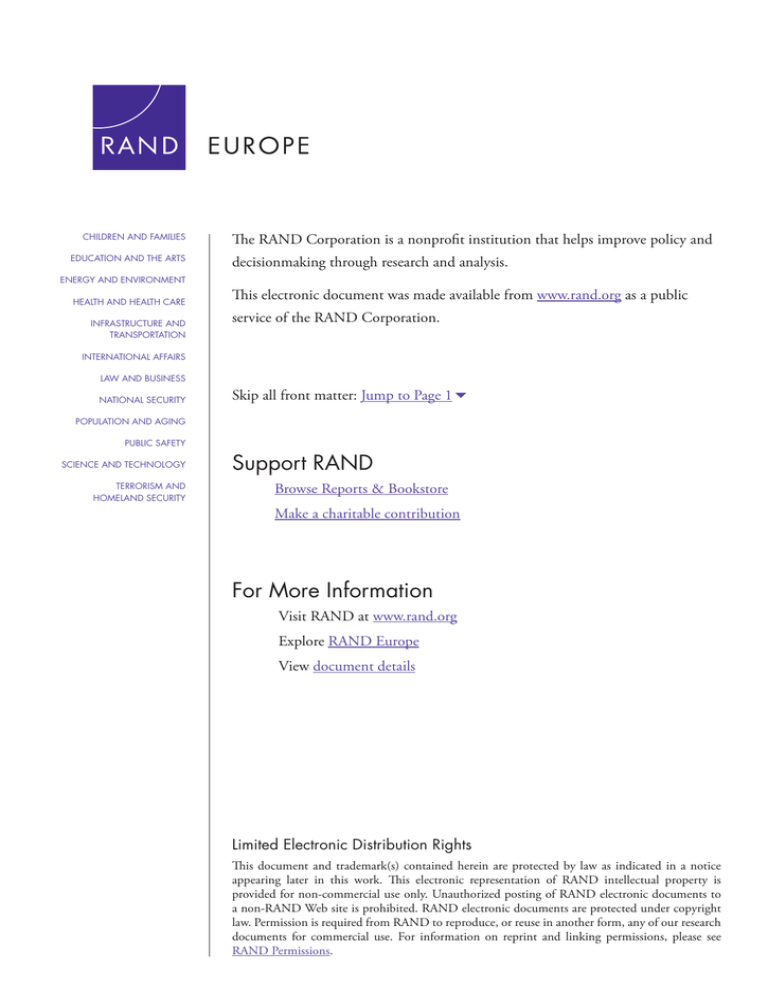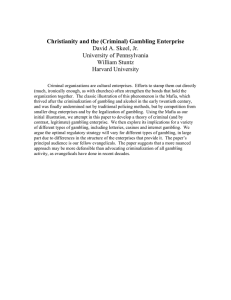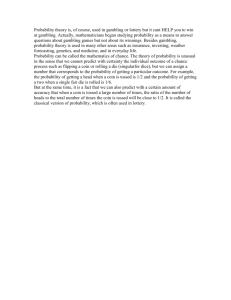The RAND Corporation is a nonprofit institution that helps improve... decisionmaking through research and analysis.
advertisement

CHILDREN AND FAMILIES EDUCATION AND THE ARTS The RAND Corporation is a nonprofit institution that helps improve policy and decisionmaking through research and analysis. ENERGY AND ENVIRONMENT HEALTH AND HEALTH CARE INFRASTRUCTURE AND TRANSPORTATION This electronic document was made available from www.rand.org as a public service of the RAND Corporation. INTERNATIONAL AFFAIRS LAW AND BUSINESS NATIONAL SECURITY Skip all front matter: Jump to Page 16 POPULATION AND AGING PUBLIC SAFETY SCIENCE AND TECHNOLOGY TERRORISM AND HOMELAND SECURITY Support RAND Browse Reports & Bookstore Make a charitable contribution For More Information Visit RAND at www.rand.org Explore RAND Europe View document details Limited Electronic Distribution Rights This document and trademark(s) contained herein are protected by law as indicated in a notice appearing later in this work. This electronic representation of RAND intellectual property is provided for non-commercial use only. Unauthorized posting of RAND electronic documents to a non-RAND Web site is prohibited. RAND electronic documents are protected under copyright law. Permission is required from RAND to reproduce, or reuse in another form, any of our research documents for commercial use. For information on reprint and linking permissions, please see RAND Permissions. This product is part of the RAND Corporation technical report series. Reports may include research findings on a specific topic that is limited in scope; present discussions of the methodology employed in research; provide literature reviews, survey instruments, modeling exercises, guidelines for practitioners and research professionals, and supporting documentation; or deliver preliminary findings. All RAND reports undergo rigorous peer review to ensure that they meet high standards for research quality and objectivity. Map the Gap a critical review of the literature on gambling-related harm Emma Disley, Alexandra Pollitt, Deirdre May Culley, Jennifer Rubin Sponsored by the Responsible Gambling Fund EUROPE The research described in this document was sponsored by the Responsible Gambling Fund. RAND Europe is an independent, not-for-profit research organisation whose mission is to improve policy and decision making for the public good. RAND’s publications do not necessarily reflect the opinions of its research clients and sponsors. R® is a registered trademark. © Copyright 2011 by Responsible Gambling Fund All rights reserved. No part of this book may be reproduced in any form by any electronic or mechanical means (including photocopying, recording, or information storage and retrieval) without permission in writing from the copyright holders. Published 2011 by the RAND Corporation 1776 Main Street, P.O. Box 2138, Santa Monica, CA 90407-2138 1200 South Hayes Street, Arlington, VA 22202-5050 4570 Fifth Avenue, Suite 600, Pittsburgh, PA 15213-2665 Westbrook Centre, Milton Road, Cambridge CB4 1YG, United Kingdom RAND URL: http://www.rand.org RAND Europe URL: http://www.rand.org/randeurope To order RAND documents or to obtain additional information, contact Distribution Services: Telephone: (310) 451-7002; Fax: (310) 451-6915; Email: order@rand.org Executive Summary In order to ‘Map the Gap’ in the available evidence base on problem gambling, the Responsible Gambling Fund (RGF) commissioned a Rapid Evidence Assessment (REA) to explore the following issues relating to problem gambling: • Prevalence among prisoners, the homeless and members of the armed forces • The effectiveness of preventative measures, treatment, and other interventions including self-exclusion, self-limitation, and support by those working in the gambling industry or in health professions • The evidence on situational features (the geographical density, clustering and distribution of gambling venues or machines) and of structural features of electronic gaming machines (such as speed of play, lights and sounds, stop buttons and whether the player can use notes or coins). Pathological gambling is a recognised a psychological disorder. Behaviours indicating problem or pathological gambling include frequent and persistent gambling, being preoccupied with gambling to the detriment of family life and financial situation, and feeling the need to gamble with increasing amounts of money to experience excitement. Although prevalence rates vary depending on the measurement tool used, and whether prevalence is looked at over the last year or a lifetime, evidence from several countries indicates a prevalence of problem gambling in the general population of around 0.5–2 percent with higher levels amongst younger people, those in lower socio-demographic groups and minorities. There is also evidence that those who have a gambling problem are more likely to suffer a range of other problems, such as substance misuse and depression. Across the eight issues of interest to the RGF the evidence on problem gambling is limited and patchy. The research has largely been conducted in North America, New Zealand and Australia, and findings from these countries are not necessarily transferable to Britain, given variations in the number and type of gambling opportunities, and difference in the public and cultural acceptability of gambling. Also, much of the empirical research into problem gambling included in this REA suffers from methodological weaknesses, which means findings are inconclusive. Prevalence in specific demographic groups The RGF asked for research into problem gambling among prisoners, service and exservice personnel and the homeless. There is evidence from other countries that prison populations have a higher prevalence of problem gambling than other sections of the xiii Map the Gap RAND Europe population, and some studies indicate that at least some offences are committed by these individuals to fund a gambling habit. There is no British research into prevalence amongst the armed services, and no studies were found from any jurisdiction about prevalence among the homeless. Prevention, treatment and other interventions Prevention programmes have been implemented and evaluated in Canada and the US. Education and prevention initiatives may succeed in increasing knowledge and awareness of problem gambling, but the extent to which they can alter behaviour is yet to be ascertained. Treatment for problem gambling has received considerable research attention, but this largely focuses on cognitive-behavioural approaches. There is good evidence that such approaches can be effective in reducing problem gambling. Other treatment approaches have not received equal research attention, nor is there sufficient evidence as to which treatments might be best-suited and most effective for different types of problem gamblers – for example, women and young people, or those with comorbid problems such as substance misuse. Evidence suggests that most people who have a gambling problem do not seek treatment and that there is a high rate of ‘natural recovery’. Available research indicates that the majority of people who enter treatment demonstrate improvements in gambling (and other) behaviours, but it is not clear whether, or the extent to which, treatment speeds up and improves natural recovery. Evaluations of self-exclusion programmes show promising results, but do not provide robust evidence of their effectiveness. Most studies do not compare outcomes among self-excluders to a control group and are therefore unable to demonstrate that selfexclusion led to reduced gambling behaviour. It is likely that those who elect to exclude themselves are motivated to reduce their gambling behaviour or have reached a breaking point; the ‘value added’ by the self-exclusion is not known. There is less evidence of the effectiveness of self-limitation strategies, and indications are that problem gamblers are least likely to impose limits on their playing. The small number of studies on selflimitation suggests the possibility of unintended consequences: if time is limited, players might compensate by increasing the amount bet, for example. There is one small study on the willingness of general practitioners in England to identify problem gamblers and signpost them to supports services. A range of professions may come into regular contact with problem gamblers, including drug treatment providers, social workers, General Practitioners and criminal justice professionals. These services could play a role in identifying individuals who have a gambling problem, providing support or referring them to treatment. Further evidence is needed in Britain on whether GPs and other health professionals have the ability or willingness to work with problem gamblers. Evidence from Canada and Australia suggests that training can be effective in improving casino employees’ knowledge about the nature and signs of problem gambling. However, the effect of training on employee behaviour (as opposed to knowledge) is not proved. There is little evidence on which to assess the transferability of these findings to the British workforce. xiv RAND Europe Executive Summary Situational and structural features Findings relating to the impact of living close to a gambling venue, and/or to several venues are mixed, and can be hard to interpret. Evidence from other countries suggests that living close to a gambling venue increases the chance that an individual will gamble, but a relationship with problem gambling is not consistently found. Individual-level variables are much stronger predictors of problem gambling, and these interact in complex ways with neighbourhood and area-level factors. Available research provides limited evidence regarding these interactions. The possibility that individuals and populations might ‘adapt’ to living in an area where there are many gambling opportunities is a topic in need of further research. There is no research into situational factors from Britain, and findings from other jurisdictions might not be transferable. The regulatory structure and the kinds of electronic gaming machines available are just two factors that vary between jurisdiction and which suggest caution about transferring findings from Canada, Australia and the US to Britain. There is a strong consensus in the literature that that electronic gaming machine use and problem gambling are closely related. However, whether electronic gaming machines contribute to the development and maintenance of problem gambling is not clear. The available evidence on the impact of structural features is very limited. There are no studies in Britain, and those conducted in other jurisdictions have limited reliability and validity. xv




